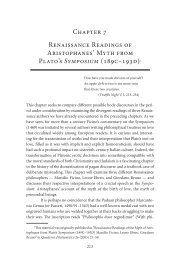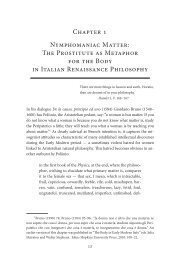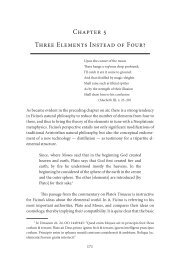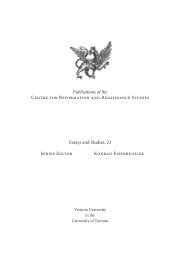Chapter 2 Matter as a Mirror: Marsilio Ficino and Renaissance ...
Chapter 2 Matter as a Mirror: Marsilio Ficino and Renaissance ...
Chapter 2 Matter as a Mirror: Marsilio Ficino and Renaissance ...
You also want an ePaper? Increase the reach of your titles
YUMPU automatically turns print PDFs into web optimized ePapers that Google loves.
<strong>Matter</strong> <strong>as</strong> a <strong>Mirror</strong> 81<br />
to this solution); or that matter becomes different on each level of being. This<br />
is the position <strong>Ficino</strong> holds in the Sophist commentary, which envisages the<br />
idea that each degree of being undergoes a radical change from p<strong>as</strong>sive <strong>and</strong><br />
hence material object to acting subject in the process of being shaped by the<br />
higher hypost<strong>as</strong>is.<br />
The closer we come to the centre of the universe, to the terrestrial<br />
realm, the less matter (the dark <strong>as</strong>pect of creation) will be able to accommodate<br />
the ever changing forms in the way they peacefully co-operate in<br />
the higher world of mental, invisible, light. 107 In the middle of the earth even<br />
celestial fire transforms into a hellish dark heat:<br />
the immense size, power <strong>and</strong> motion of celestial beings<br />
brings it about that all the rays of all the stars penetrate in a<br />
moment the m<strong>as</strong>s of the earth (which is <strong>as</strong> a point in relation<br />
to the sky) <strong>and</strong> with consummate e<strong>as</strong>e straight to the centre.<br />
In the centre, <strong>as</strong> the Pythagoreans <strong>and</strong> Platonists would have<br />
it, the rays are strongest, both because they touch the centre<br />
perpendicularly on all sides <strong>and</strong> because they are all collected<br />
in a confined space. By the ray’s intensity, the material of<br />
the earth there — being dry <strong>and</strong> far from any moisture —<br />
is immediately kindled, <strong>and</strong>, once kindled, is vaporized <strong>and</strong><br />
dispersed through channels in all directions <strong>and</strong> blows out<br />
both flames <strong>and</strong> sulphur. But they think that this fire is very<br />
dark <strong>and</strong>, <strong>as</strong> it were, a sort of flame without light, just <strong>as</strong> the<br />
heavens light is without flame, where<strong>as</strong> the fire between the<br />
celestial <strong>and</strong> the infernal combines light <strong>and</strong> heat. 108<br />
107 In Timaeum chapt. XVII[I], OO 144/441: “non solum vero distinctionem formarum,<br />
sed etiam repugnatiam videmus in mundo, procedit enim a primo, & procedendo<br />
degenerat. Processio quidem distinctionem facit: degeneratio repugnantiam.”<br />
108 De vita III, 16: 320–332: “Immensa ferme coelestium magnitudo, virtus, motio<br />
facit, ut omnes omnium siderum radii terrae molem, quae qu<strong>as</strong>i punctum est ad coelum,<br />
momento facillimeque usque ad centrum recti penetrent, […]. Ibique, ut placet Pythagoreis<br />
atque Platonicis, fortissimi sunt, tum quia recti undique centrum tangunt, tum<br />
quia in angustum collecti sunt cuncti. Quorum vehementia materia ibi terrae sicca, procul<br />
ab humore remota, prorsus accenditur accensaque extenuatur atque dispergitur per meatus<br />
undique et efflat incendia pariter atque sulphur. Sed ignem hunc putant valde caliginosum<br />
esse et qu<strong>as</strong>i incendium quoddam luminis expers, sicut in coelo extat expers incendii<br />
lumen; ignis autem inter coelestem atque infernum luminem cum fervore coniungit.” In







